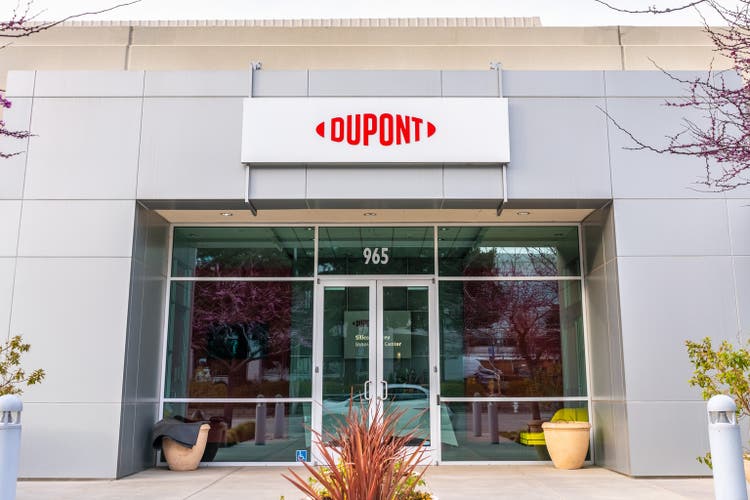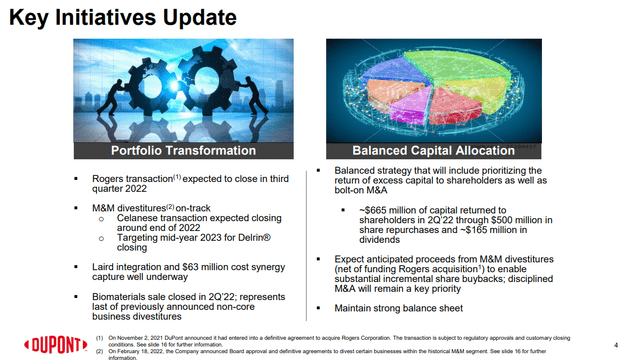Sundry Photography/iStock Editorial via Getty Images
Longer-term fundamentals remain intact at DuPont de Nemours (NYSE:DD), despite warnings of headwinds affecting its third quarter outlook.
The loss of contribution from its divested biomaterials business, unplanned downtime at its Spruance site in Virginia and the strong dollar forced the specialty chemicals company on Tuesday to issue weaker guidance for Q3 net sales and earnings. DuPont now expects to earn about $0.81 per share from net sales of between $3.17-3.37 billion in the third quarter – significantly less than the average analyst estimate of $0.90 per share in adjusted EPS and $3.4 billion in net sales.
Resilient Demand
This came against a very robust set of second quarter figures – adjusted EPS in Q2 was 11% higher on the prior year quarter, at $0.88 per share. The Q2 result greatly exceeded analysts’ estimates of $0.75 per share, thanks to higher segment earnings and a lower share count due to stock repurchases. And on the back of resilient demand from key end markets, particularly semiconductors, general industrial, water and construction, net sales of $3.3 billion increased by 7% to $3.3 billion.
“We delivered second quarter financial results ahead of expectations by maintaining a disciplined focus on pricing actions and operational excellence in the face of continued global supply-chain and logistics challenges and ongoing inflationary pressure… Underlying demand during the quarter in our key end-markets remained strong.”
Chief Executive Officer Ed Breen, DuPont Q2 2022 Earnings Release
Looking ahead, the company expects the impact of higher costs associated with raw materials, logistics and energy to be even bigger than previously expected. Against an earlier estimate of about $600 million of increased costs, it now expects inflation to cost the firm an extra $700 million, primarily due to higher energy and logistics costs.
That being said, DuPont is doing well to weather big inflationary cost pressures due to its strong pricing power and resilient demand. “Our pricing actions have fully offset cost inflation on a dollar basis but have impacted EBITDA margins,” said Chief Financial Officer Lori Koch in its earnings call.
Higher prices drove an 8% increase in organic sales in the quarter, which along with 1% higher volumes, pushed organic sales growth to 9%. For the group as a whole, operating EBITDA margin was 25% in Q2 2022, flat on both a year-over-year and sequential basis.
New Guidance From DuPont
The strong result from Q2 has meant the firm is still on track to meet its full year EPS target, in spite of the reduced expectations for the current quarter. For the 2020 full year, management narrowed its adjusted EPS range, with the midpoint of its guidance being equal to its previously guided range. It now expects full year adjusted EPS of between $3.27-3.43 per share, against $3.20-3.50 per share from its earlier guidance.
However, net sales for the full year has been revised downwards, to $13.0-13.4 billion, against $13.3-13.7 billion previously. Like many big multinational firms, DuPont is not immune to foreign currency headwinds, and so a stronger dollar forced it to expect a further $200 million reduction in revenues for the full year.
Portfolio Repositioning
DuPont is in the middle of a transformation that began from its demerger from DowDuPont in 2019. The dissolution of the chemicals giant into three separate companies, enabled each to focus on different segments of the market. DuPont inherited the specialty chemicals business, which produces polymer composites, high performance materials, among other products – it was the lower volume, but higher margin and faster growing division of DowDuPont.
Post-demerger, it has been busy simplifying its portfolio and repositioning itself towards less cyclical markets. By sharpening its focus, it is hoping to maintain its innovation leadership, which ultimately underpins its competitive advantage. In turn, this should help DuPont’s top-line growth, operating EBITDA margins and cross-cycle earnings stability and, in the long term, unlock shareholder value too.
Chief Executive Officer Ed Breen, a well-known deal maker, is not shy from using M&A and divestitures to hasten and reinforce the transformation of DuPont. The company struck a deal to acquire Rogers for $5.2 billion back in November 2021, in an effort to increase its exposure to electric vehicles and semiconductors – two highly specialized fast growing end-markets where the company sees long-term secular growth.
DuPont 2022 Q2 Results Presentation
The Rogers transaction follows on from its acquisition of Laird Performance Materials for $2.3 billion earlier in 2021, which was another complementary fit with DuPont’s existing electronics portfolio. Synergies from the Laird deal are already coming through, with management identifying $63 million in savings from the merger and Laird having contributed $0.11 per share to earnings in Q2.
Yet, DuPont remains on the lookout for a couple more targets, as it seeks further accretive and opportunistic bolt-on transactions that can enhance its market position. At the same time, DuPont intends to divest a substantial portion of its more cyclical mobility and materials business, as it seeks to refocus only on areas where it has the necessary scale to compete effectively against its rivals.
Final Thoughts
It would seem then that the Q3 guidance was mainly affected by a series of one-off factors rather than a deterioration of underlying demand. This is encouraging, because it shows that the longer-term fundamentals are intact.
The company has a wide economic moat that is underpinned by its innovation focus and entrenched market position. And although the macroeconomic environment remains uncertain, DuPont remains attractively positioned to benefit from secular growth trends in the changing economic landscape, particularly with respect to the adoption of IoT devices and electrical vehicles.


Be the first to comment